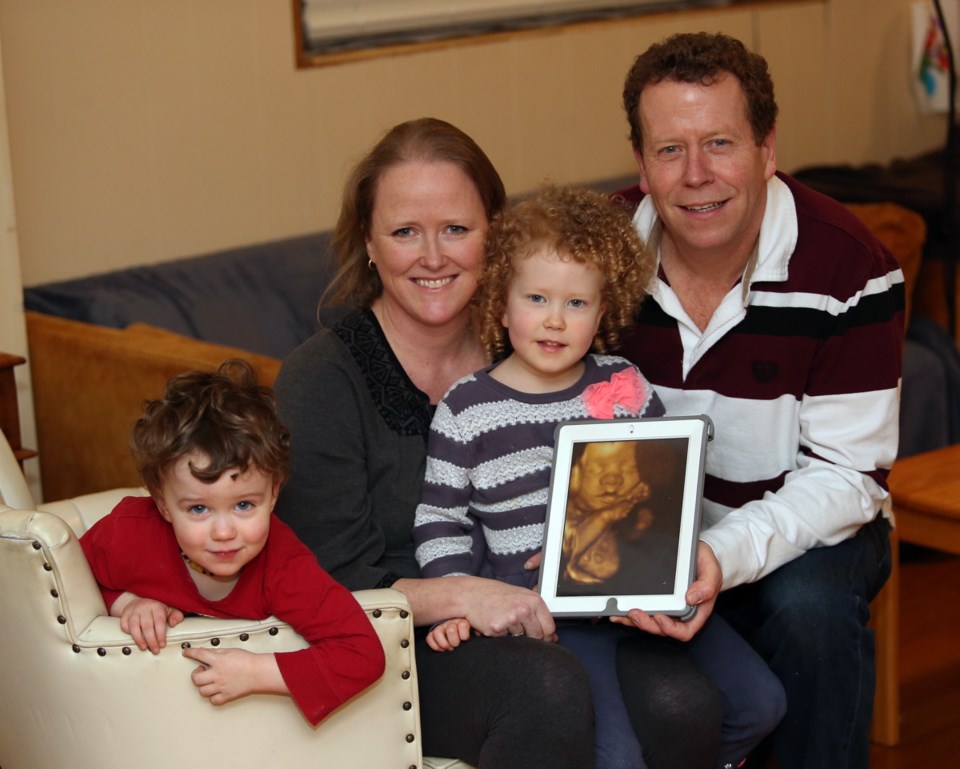Victoria mom Shauna Pengelly figured motherhood would bring enough surprises, so she was determined to learn her baby’s sex via ultrasound ahead of the birth.
Pengelly and her husband, Peter Lawton talked it over and agreed. But at the time, health policies in B.C. were leaving some doubt as to whether technicians or doctors would agree to reveal the sex of unborn babies. So they opted to pay for their own ultrasound examination and pictures at a private clinic.
“We just really wanted to know,” said Pengelly.
“A girlfriend told me one of the coolest things in the world was to hear ‘It’s a boy’ or ‘It’s a girl.’ I was OK not having that moment.”
That was for their first child, Betty, now four. Two years later, when George, now two, was about to be born, the couple again opted to go to the private clinic.
By then, health policies about revealing the sex of a baby had changed. Parents can now find out the sex of their baby from their doctors.
But Pengelly and Lawton wanted the extra resolution and clarity that comes when the examiner is looking for an image of the baby.
Medical ultrasound examiners are more inclined to look for something like signs of healthy heart development than any expression on the face.
“Regular ultrasound is black and white and doesn’t really show facial features,” said Pengelly. “It shows more structures and bones and organs instead of the actual little human inside you.”
Ultrasound-generated in-utero baby pictures have become a popular memento of modern parenthood.
But with health-care resources always strapped, government medical authorities frown on medical imaging being used to collect souvenir images of a healthy pregnancy.
So, private companies have stepped in, like UC Baby in Royal Oak, with picture and video packages ranging in cost up to about $200.
These clinics routinely make their examination later in the pregnancy, 25 weeks as opposed to the 18 to 20 weeks recommended by Island Health. So the pictures are of a much more developed baby.
Also, the private technicians can concentrate on using the technology to capture an image of the baby instead of looking for something like medical abnormalities in internal organs.
The results of these in-utero baby pictures are so good, many clinics advertise them as 3-D, even 4-D if a video recording of the baby’s movements is desired.
But some medical authorities, notably in the U.S., are voicing caution over what some are calling the “recreational” use of ultrasound imaging.
In December, the U.S. Food and Drug Administration even issued an advisory warning women against seeking ultrasound pictures outside a medical setting. Other medical groups, including the American Congress of Obstetricians and Gynecologists, the American Medical Association and American Institute of Ultrasound in Medicine, have also denounced ultrasound souvenir pictures.
While most of these groups concede there is almost no evidence to indicate ultrasound examinations cause any harm to a developing baby or the mother, objections arise because it’s unknown if prolonged or repeated ultrasounds can do harm.
On Vancouver Island, Dr. John Matheson, Island Health medical director of medical imaging, said hundreds of studies have failed to show any real danger with ultrasound examinations.
Matheson agreed that any procedure carries some risk. But with ultrasounds, the risk is tiny, “vanishingly small.” “I don’t have any problem with [souvenir ultrasound pictures] and none of the radiologists I know have any problems,” he said.
On the other hand, Matheson said, he and Island Health do object to the spending of public money to create an ultrasound photo keepsake or souvenir.
When a woman undergoes her first ultrasound, the health authority routinely provides a photograph as a gesture. But the examination is still a medical procedure. It’s a different matter, however, when a patient pays for a picture privately.
“It’s a free country and if people want to get pictures of their babies before they are born, I don’t have any problem with that,” he said.
Dr. Tina Ureten, manager and founder of UC Baby, which is now operating in 27 locations, said her company has been in business for 12 years without any mishap.
Ureten said a well-taken 3-D scan picture, one where the features of the baby’s face are clear, can provide huge benefits for a mother and family.
“There is research that shows when a mother sees a good 3-D image of their baby, they take better care of themselves,” she said. “Also, with siblings and fathers there is a good bonding with the baby.”
A radiologist herself, Ureten said she has read a few of the studies advising caution. But they were animal studies, involving sedated or restrained subjects, and far from conclusive.
“When you put a rat under a machine and don’t let it move around, it creates a lot of stress,” she said. “The animal doesn’t volunteer to lie down and let you finish your scan.”
Meanwhile, Pengelly said she always assumed an ultrasound picture was safe and the keepsake was worth the money.
“My father is a retired radiologist and he never had any misgivings,” she said. “That helped.
“We just always thought it would be cool for [the kids] to look at the pictures when they were older and see what they looked like in their mom’s tummy.”
For more information about ultrasound examinations and pictures, go to viha.ca/children/pregnancy/ and click on Ultrasound Fact Sheet. To learn more about UC Baby 3D Ultrasound, go to ucbaby.ca, click on locations and look for Victoria.
